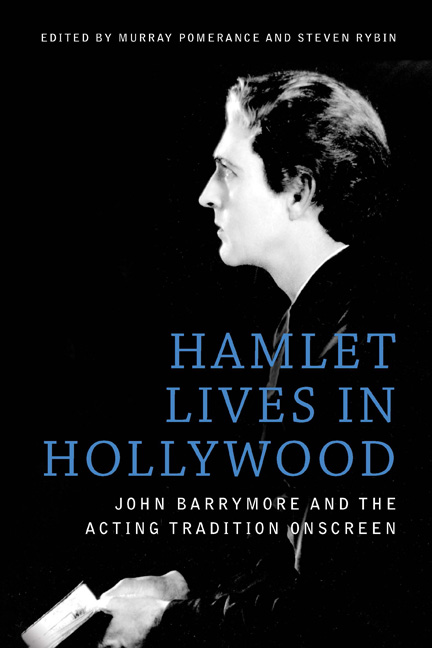Book contents
- Frontmatter
- Contents
- List of Figures
- The Contributors
- Acknowledgments
- Introduction
- 1 The Pre-Bard Stage Career of John Barrymore
- 2 Dangerously Modern: Shakespeare, Voice, and the “New Psychology” in John Barrymore's “Unstable” Characters
- 3 The Curious Case of Sherlock Holmes
- 4 John Barrymore's Introspective Performance in Beau Brummel
- 5 “Keep Back your Pity”: The Wounded Barrymore of The Sea Beast and Moby Dick
- 6 From Rome to Berlin: Barrymore as Romantic Lover
- 7 The Power of Stillness: John Barrymore's Performance in Svengali
- 8 Prospero Unbound: John Barrymore's Theatrical Transformations of Cinema Reality
- 9 A Star is Dead: Barrymore's Anti-Christian Metaperformance
- 10 Handling Time: The Passing of Tradition in A Bill of Divorcement
- 11 John Barrymore's Sparkling Topaze
- 12 “Planes, Motors, Schedules”: Night Flight and the Modernity of John Barrymore
- 13 Barrymore and the Scene of Acting: Gesture, Speech, and the Repression of Cinematic Performance
- 14 “I Never Thought I Should Sink So Low as to Become an Actor”: John Barrymore in Twentieth Century
- 15 Barrymore Does Barrymore: The Performing Self Triumphant in The Great Profile
- Works Cited
- Index
9 - A Star is Dead: Barrymore's Anti-Christian Metaperformance
Published online by Cambridge University Press: 23 June 2018
- Frontmatter
- Contents
- List of Figures
- The Contributors
- Acknowledgments
- Introduction
- 1 The Pre-Bard Stage Career of John Barrymore
- 2 Dangerously Modern: Shakespeare, Voice, and the “New Psychology” in John Barrymore's “Unstable” Characters
- 3 The Curious Case of Sherlock Holmes
- 4 John Barrymore's Introspective Performance in Beau Brummel
- 5 “Keep Back your Pity”: The Wounded Barrymore of The Sea Beast and Moby Dick
- 6 From Rome to Berlin: Barrymore as Romantic Lover
- 7 The Power of Stillness: John Barrymore's Performance in Svengali
- 8 Prospero Unbound: John Barrymore's Theatrical Transformations of Cinema Reality
- 9 A Star is Dead: Barrymore's Anti-Christian Metaperformance
- 10 Handling Time: The Passing of Tradition in A Bill of Divorcement
- 11 John Barrymore's Sparkling Topaze
- 12 “Planes, Motors, Schedules”: Night Flight and the Modernity of John Barrymore
- 13 Barrymore and the Scene of Acting: Gesture, Speech, and the Repression of Cinematic Performance
- 14 “I Never Thought I Should Sink So Low as to Become an Actor”: John Barrymore in Twentieth Century
- 15 Barrymore Does Barrymore: The Performing Self Triumphant in The Great Profile
- Works Cited
- Index
Summary
Silent Hollywood stars who continued to play leading roles in the sound era were often said to have survived the industrial transition. Yet, in a way, every silent star died, for audiovisual performance is a different métier. We might more accurately say that those actors who persisted, such as John Barrymore, were resurrected for, and through, sound. In Barrymore's case, the studios could thank the heavens. The voice fitted the famous profile. He would not go the way of some of his peers, such as Douglas Fairbanks, Sr., or that other romantic leading John, John Gilbert (on Barrymore's transition to sound see Fowler 324). This may have seemed predictable at the time, given Barrymore's fame onstage, in a period when actors’ voices were highly trained, and because he had even recorded Shakespearean soliloquies for Famous Records and RCA Victor. Nevertheless, there is no face more silent than a profile. Mouths are shut in profiles. We gaze at a profile; we do not expect it to speak. In fact, it is because of his history as respected Shakespearean stage actor, silent screen star, and sound movie star that Barrymore presents a unique case for thinking about the relation of stage to screen acting—and of silent acting to audiovisual acting—as Hollywood learned to speak. To do this, I shall focus on Barrymore's work with George Cukor, a director known for his keen interest in the institution of stardom, in such films as What Price Hollywood? (1932), A Double Life (1947), The Actress (1953), and A Star is Born (1954) (see Pomerance and Palmer; Phillips). Cukor's work with Barrymore is, I shall show, particular to Barrymore; yet, in that specificity, it critiques the way that foundational myths of Hollywood stardom comport with Christian attitudes toward the births and deaths of celestial beings.
Barrymore's legendary theatrical family was central to the proliferation of what “legitimate” stage actors ought to sound like as the New York theater scene developed into what we now think of as “Broadway”—meaning that middle classes began to have access to it in industrialized New York. In the 1920s, Barrymore made the transition from being the most celebrated American Shakespearean actor to the Hollywood screen where he became a household name as a dashing leading man. Then, as the 1930s inhaled and began to yawn, both Barrymore and the country entered a depression.
- Type
- Chapter
- Information
- Hamlet Lives in HollywoodJohn Barrymore and the Acting Tradition Onscreen, pp. 109 - 122Publisher: Edinburgh University PressPrint publication year: 2017



